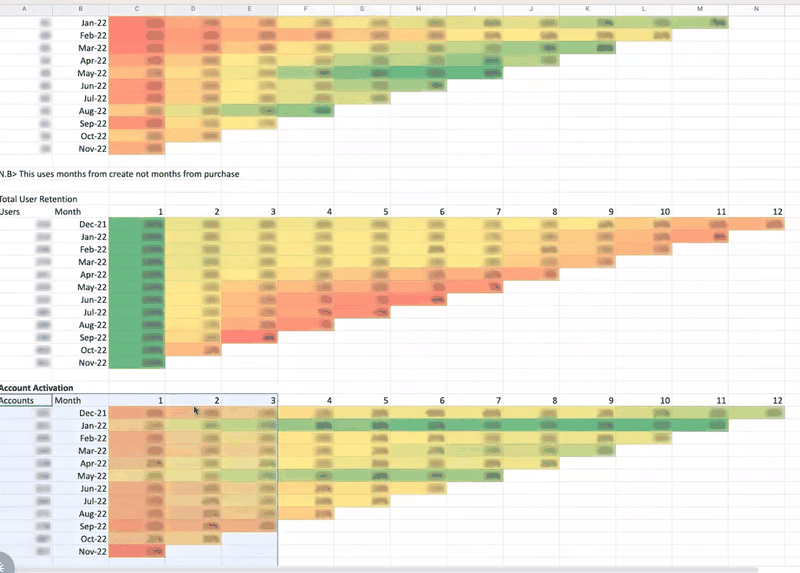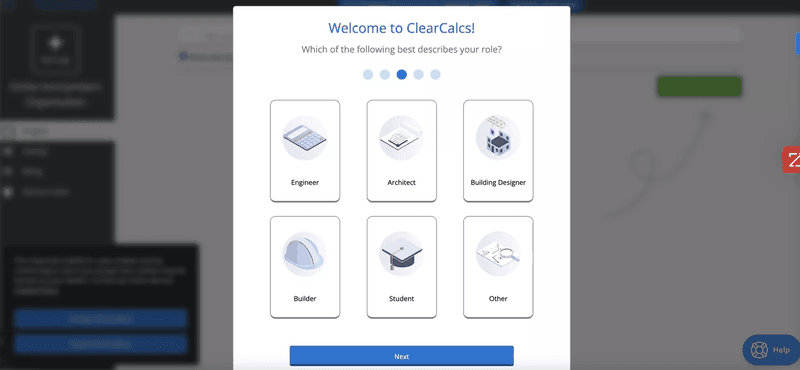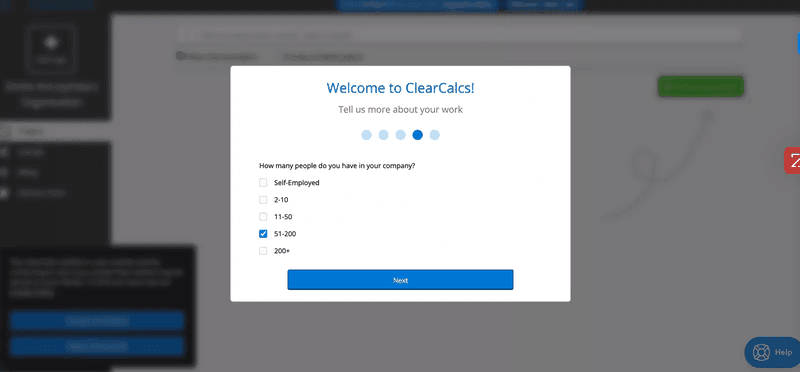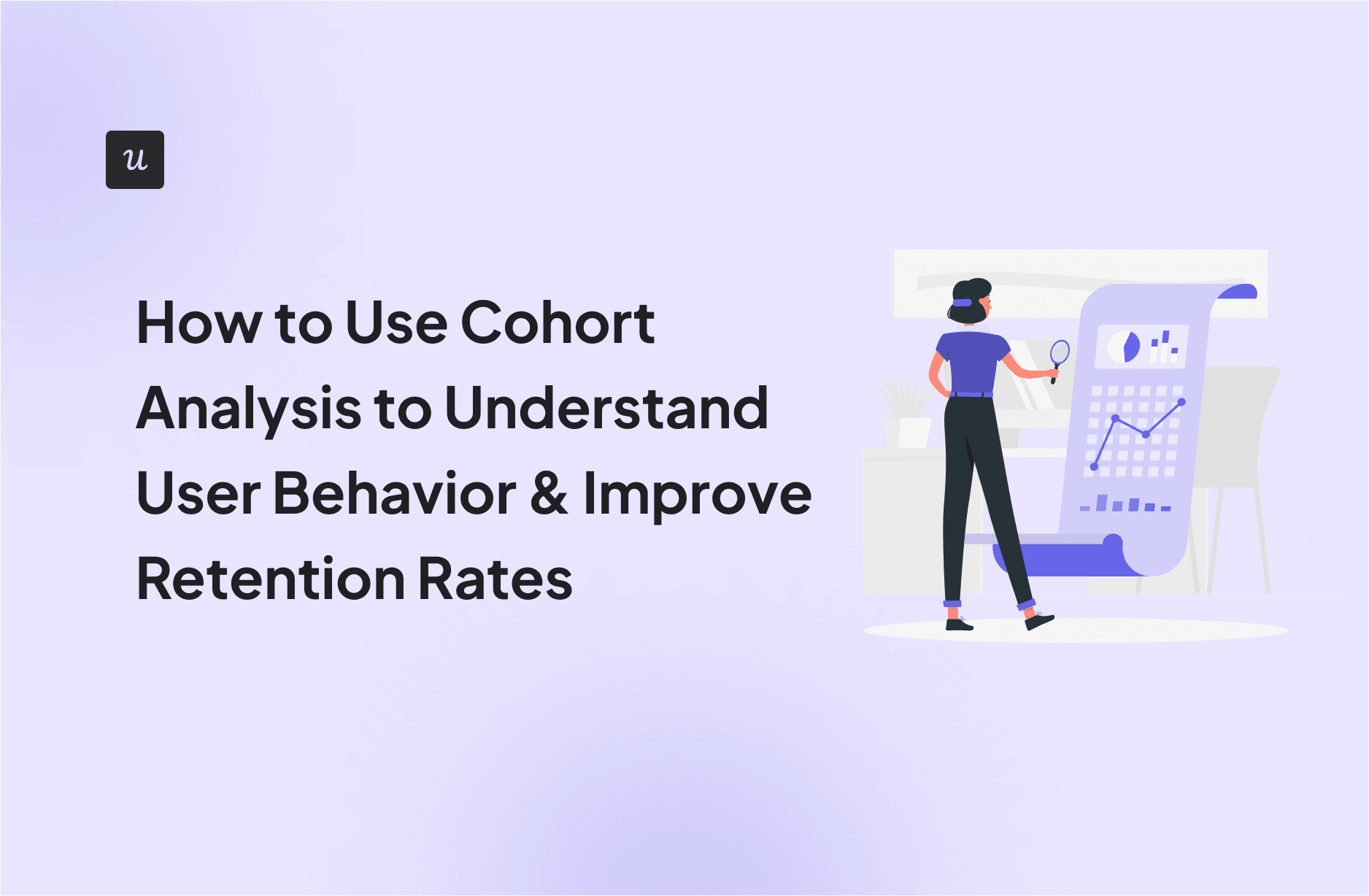
How to Use Cohort Analysis to Understand User Behavior & Improve Retention Rates
Cohort analysis keeps you from optimizing to the mean by comparing how distinct user groups behave based on the actions they took.
Cohort analysis helps answer questions like:
- Are we getting better at retention?
- What specific actions drive that retention?
- Which acquisition channels actually deliver users who stick around?
Here’s how it works: You group users who share a meaningful characteristic (e.g., everyone who completed onboarding) and then track how those cohorts behave relative to one another. If one group consistently retains better, engages more deeply, or churns less, you’ve identified a behavior that likely contributes to long-term stickiness.
With product analytics tools like Userpilot, you can segment users, quantify retention deltas, and pinpoint which feature interactions create long-term users versus the ones people bounce off right before they churn.
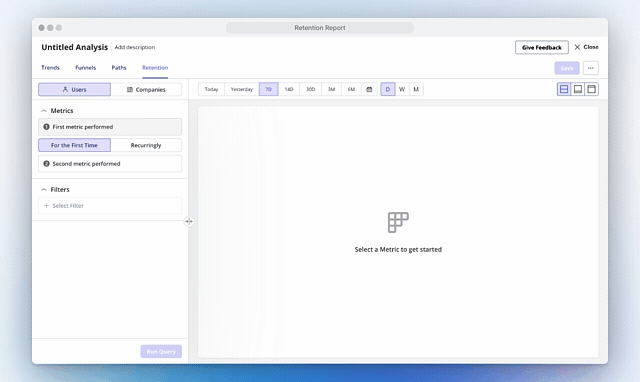
Try Userpilot Now
See Why 1,000+ Teams Choose Userpilot

Types of cohort analysis
While you can slice data infinitely, I focus on two specific cohort types that yield the highest ROI. One diagnoses your product’s health; the other validates the value of your features.
1. Acquisition cohorts (the “when”)
This type of cohort analysis groups users based on when they signed up or made a purchase. I use acquisition cohorts to audit the long-term health of our user onboarding. For example, to measure the impact of a June feature release, I compare the retention rate of the June cohort against the May cohort. This isolates variables such as:
- Seasonality: Do users acquired in December churn faster than January users?
- Campaign quality: How many users from that expensive LinkedIn campaign in April actually stay?
- Onboarding Success: Did new user retention improve after we patched the signup flow?

2. Behavioral cohorts (the “why”)
Behavioral cohorts tell you why users disengage. These are cohorts based on specific actions users took (or failed to take) inside your product. I run experiments comparing different cohorts to prove feature adoption value:
- Cohort A: Users who used “Reporting” in their first 3 days.
- Cohort B: Users who did not use “Reporting” in their first 3 days.
If Cohort A has higher retention, you have found a correlation. This proves that getting users to the reporting feature early is critical for customer stickiness. You define these behaviors using custom events in your analytics tool.
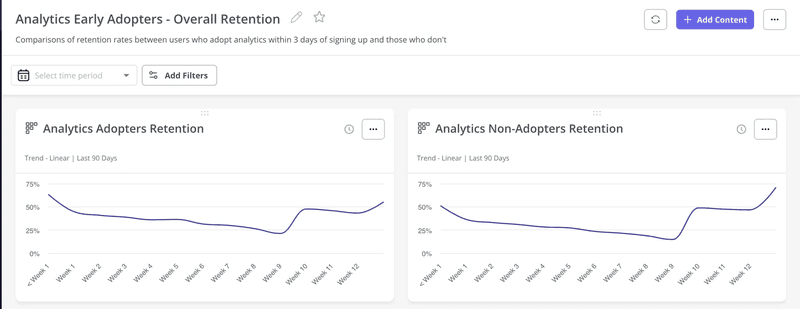
How actionable is your current cohort analysis strategy?
What is your primary goal with retention data?
How do you currently act on insights from your cohorts?
Stop Analyzing. Start Engaging.
Don’t just watch users churn. With Userpilot, you can segment users based on behavior and instantly trigger in-app experiences to retain them.
How to perform cohort analysis?
Running cohort analysis in Userpilot is straightforward. Our platform handles the heavy lifting (like date alignment, statistical calculations, and data visualization) so you can focus on interpreting the results.
Navigate to retention reports and select your analysis level
Open the Retention page from your analytics dashboard or through the ‘Create Report’ button.

Then, decide whether to analyze at the user level or the company level. For B2C products or individual user interactions, choose user-level analysis. For B2B SaaS where you track accounts, you can switch to company-level to measure how entire organizations engage with your product over time.

Define your starting and returning metrics
Next, specify which actions matter for your retention analysis. The starting metric defines who enters your cohort. This metric could be “Signed Up,” “Completed Onboarding,” or “Created First Project.”
The returning metric defines what retention means for your product—typically actions like “Logged In,” “Used Core Feature,” or “Invited Team Member.”
You can pull these metrics from three sources:
- Tracked events (labeled or custom).
- Page views from your tagged pages.
- Engagement with your in-app content, like tooltips and checklists.
Choose your measurement method
Decide whether to count unique users or total occurrences. Unique users count each person once per cohort entry, which works for most retention analysis. If a user signs up on Monday, they’re measured from that Monday forward.
On the other hand, the total count allows users to re-enter your cohort multiple times during the analysis period, helping track repeated behaviors, such as weekly feature usage.
Apply filters to isolate specific segments
Filter your data to focus on the cohorts that matter most. You can segment by:
- Event properties like “Plan Type: Premium.”
- User properties like “Role: Admin.”
- Company properties (like “MRR: >$500”).
- Pre-built segments you’ve created in Userpilot.
For example, you can filter to show only users who completed a specific action during onboarding, and compare their retention with those who didn’t.
Analyze your retention trend and cohort table
Click ‘Run Query’ and configure your view settings. Choose your cohort chart period (last 7 days, 30 days, or custom range), select platform (web, mobile, or both), and set your data point interval (daily, weekly, or monthly).

You’ll see two visualizations:
- Retention trend: Shows average retention rates over time as a line graph, revealing whether your product is getting stickier.
- Retention table: Displays the raw cohort data. Each row represents users who performed the starting action on a specific date. In comparison, each column shows what percentage returned on each day, week, or month within the specified period.
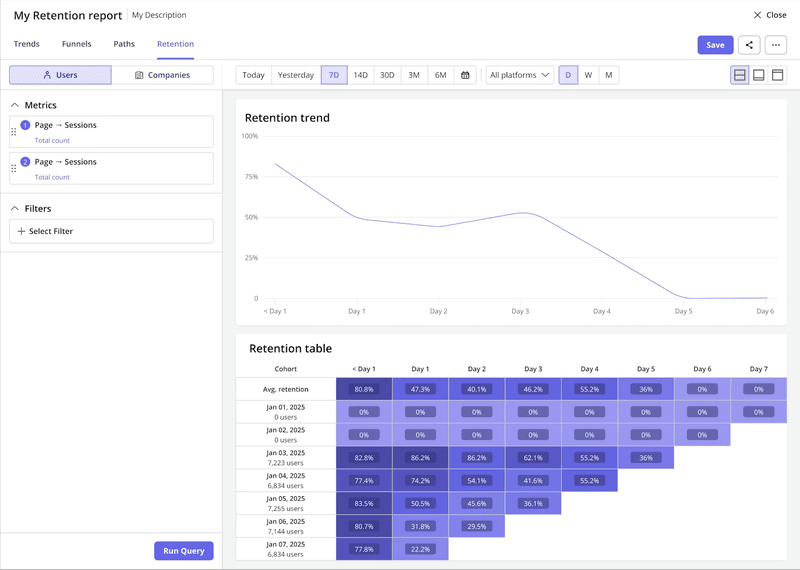
For example, if your starting event is “Created Report” and returning event is “Viewed Report,” a row showing October 6th with 15 users means those 15 people created their first report that day.
If 66.7% returned the same day and 33.3% returned the next day, you know that one-third of users came back within 24 hours to view their work: a strong signal of user engagement.
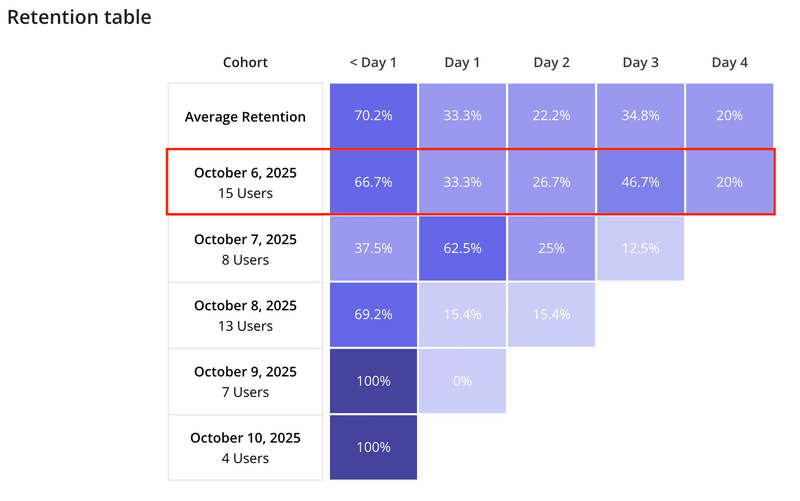
Best practices when looking at customer cohort analysis
Here’s how we decode cohort tables to find valuable insights.
Identify patterns by decoding horizontal and vertical reads
The retention table is a grid that tells a story of how users drop off. When you open a retention report, read it in these three directions to gain a deeper understanding and diagnose different problems:

Vertical read: Scan down a specific column, such as “Month 2.” You are comparing how well you retained January’s users vs. March’s users at the same point in their lifecycle. If numbers increase as you go down, your product is getting stickier. If they drop, you’re either attracting lower-quality leads or recent product changes are creating user friction.
Horizontal read: Read a single row from left to right to see how a specific group behaves over time. Your goal is to flatten the curve. If the line stabilizes at 20%, you have a sustainable business with a core user base. If it trends to zero, you probably have a product-market fit problem.
Diagonal read: The diagonal represents calendar time. Let’s say you see a sudden drop across multiple cohorts (rows) at the same specific point (diagonal). It indicates an external variable, such as a server outage or a pricing change.
Combine cohort analysis with qualitative data to get the full picture
Cohort analysis tells you what is happening; qualitative data tells you why. Combine the data with these tools:

Use behavioral cohorts to drive feature adoption
I recommend using behavioral cohorts to compare retention between users who use a specific feature (e.g., “Export Report”) and those who don’t. If the “Export” group retains 40% better, that is your habit-forming feature.
To drive feature adoption, direct users to this feature using subtle native tooltips. For example, if a user hits Day 30 without touching your “Reports” tab but has logged in 15+ times, display a tooltip that says “See how teams like yours use Reports to cut review time by 40%.”
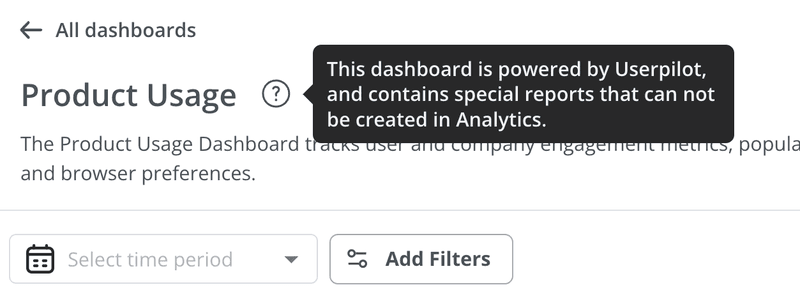
Improve customer retention rates based on insights from cohort analysis
Cohort analysis without action is trivia. Apply the scientific method to your retention strategy by treating every fix as a hypothesis you can validate:
- Hypothesize: If your retention table shows a 30% drop between Week 1 and Week 2, identify the friction point. Maybe users aren’t inviting teammates, which kills engagement. Your hypothesis: “If I add a tooltip to the ‘Invite’ button, Week 1 retention will increase by 5%.”
- Test: Run an A/B test in Userpilot. Show a new experience or tooltip to 50% of new signups. Both groups enter the same retention analysis, but they’re tagged differently (Treatment vs. Control). This isolates the variable so you don’t have to guess whether the change worked.
- Measure: Revisit your retention table after a few weeks to compare cohorts. For example, compare the “Treatment” cohort against the “Control” cohort. Let’s say the Treatment cohort retains at 68%, while the Control cohort retains at 63%. Then, you’ve validated a scalable improvement. If the change is negligible, test something else.
Start by finding your steepest drop-off point. Use a product growth platform to deploy a fix, and watch whether the curve flattens. Then iterate to increase customer retention.
Common traps to avoid when performing cohort analysis
These three mistakes will lead you to the wrong conclusions and waste time fixing problems that don’t exist. Avoid them to practice effective cohort analysis.
- Mixing “calendar date” and “tenure”: Align users by their start acquisition date (Day 0), not the calendar date. Day 1 for a Monday signup is Tuesday. Day 1 for a Friday signup is Saturday. If you align by calendar date, you’re comparing different lifecycle stages (e.g., a user’s Day 3 gets lumped with another user’s Day 7).
- Ignoring segment size: Retention rates for tiny groups (e.g., 10 people) fluctuate wildly. For example, one person churning tanks your retention by 10%. Before you react to a “drop” in such a small cohort, check if you have enough volume to trust the signal.
- Focusing only on revenue: Revenue churn is a lagging indicator. Users stop using the product (activity churn) weeks before they cancel payment. If you’re only watching MRR retention, you’re diagnosing the problem after it’s unsolvable. Monitor activity-based retention first(e.g, login frequency, feature usage, core action completion).
Cohort analysis example
ClearCalcs, a structural design platform, faced an issue: new users couldn’t find the right calculator within 10 minutes and churned before completing their calculations. Their NPS data showed that existing customers praised the simplicity, while new users were overwhelmed by the number of options.
With Userpilot, ClearCalcs used cohort analysis to segment activation by account type and analyzed it at the company level.
They discovered that paying accounts weren’t activating until five months or later. The pattern: one person would purchase, add six or seven colleagues to the account, and those invited users wouldn’t log in for months.
They used Userpilot to build personalized onboarding flows. Welcome surveys segmented users by role, goals, and company size.
Based on these answers, ClearCalcs routed users to specific calculator types relevant to their job.
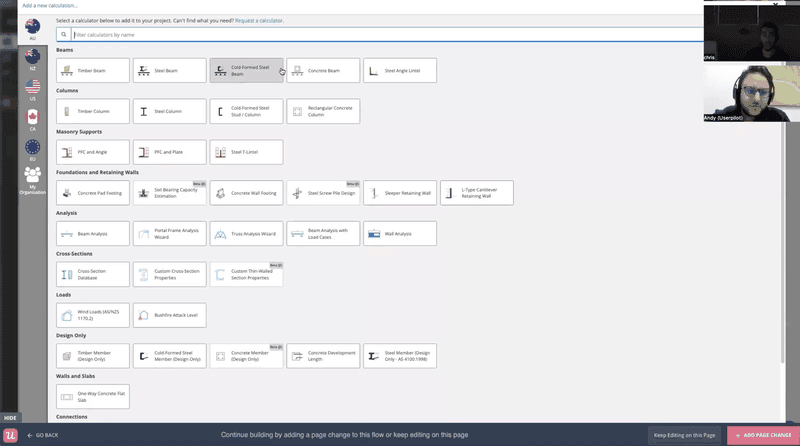
CEO Chris Borzillo describes their approach:
“We use Userpilot to find 10,000 ways of how not to onboard someone…in the hope that the 10,001 will show us the right way.”
The results: activation improved across every segment they tracked. Cohort analysis helped ClearCalcs to identify the problem, test solutions, and validate which changes actually drove users to value faster.
Start measuring retention the way it actually works
We’ve come to the end of this guide to cohort analysis. With segmenting retention by behavior, you will identify their activation triggers faster, validate product changes with real data, and compound small retention wins into structural growth.
Ready to stop guessing which features drive retention? Book a demo and see how to use our platform to track behavioral cohorts, compare retention across user segments, and deploy fixes without waiting on engineering sprints.
FAQ
What is cohort analysis?
Cohort analysis is a method of tracking user segments(grouped based on shared characteristics) within a defined timeframe to measure how customer behavior changes over time. Instead of analyzing all users as one group, you group them into cohorts like everyone who signed up in March or everyone who used a specific feature in their first week. Then, compare retention rates, behavior patterns, or churn rates across these groups. This approach reveals trends, such as whether your April product update actually reduced churn or whether users from paid ads retain better than organic signups.
When to use cohort analysis?
Conduct cohort analysis when you need to:
- Measure user retention rates over time.
- Validate product changes by comparing user groups before and after updates.
- Identify which features create loyal customers versus which ones users ignore before churning.
- Analyze cohorts to see whether they retain better than older ones.
- Isolate the impact of specific variables like marketing campaigns or onboarding changes.
It’s especially valuable when your aggregate metrics look stable, but you suspect specific segments are struggling. Also, when you need to prove whether a product experiment actually improved user experience.
What are the two types of cohort analysis?
The two main types of cohort analysis are:
- Acquisition cohort analysis: Group users based on when they signed up or made their first purchase. It lets you compare retention between users who joined in different time periods to measure whether your product is getting stickier over time.
- Behavioral cohort analysis: Group users based on specific actions they took or didn’t take inside your product. This type enables you to identify how different cohorts engage in correlation with higher retention and prove which features drive customer stickiness.
What is an example of a cohort study?
ClearCalcs ran a cohort study comparing activation rates across user segments by role, account type, and company size. When they analyzed paying accounts at the company level instead of the individual user level, they discovered accounts weren’t activating until five months after purchase because one buyer would add multiple colleagues who wouldn’t log in for months.
They used Userpilot to deploy personalized onboarding flows that segmented users by role and goals, routing each person to relevant calculators. By comparing treatment cohorts against control cohorts, they validated that activation improved across every segment, with invited users activating within days instead of months.
How to study growth using cohort analysis?
You can study growth using a cohort analytics tool like Userpilot to:
- Track retention curves for each monthly signup cohort and look for flattening. If your June cohort retains at 35% by Month 6 while your March cohort only hit 25%, your product is getting stickier.
- Compare activation rates across cohorts to measure whether recent product changes drove users to value faster.
- Use behavioral cohorts to identify which actions correlate with higher retention. Then, measure whether more users in recent cohorts are completing those actions.
- Analyze churn rate by cohort to spot if specific groups acquired through certain channels or targeted campaigns have higher customer lifetime value.


